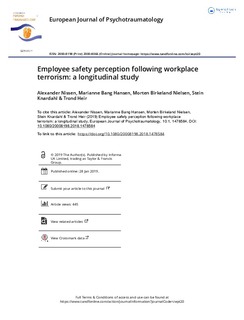| dc.contributor.author | Nissen, Alexander | |
| dc.contributor.author | Hansen, Marianne | |
| dc.contributor.author | Nielsen, Morten Birkeland | |
| dc.contributor.author | Knardahl, Stein | |
| dc.contributor.author | Heir, Trond | |
| dc.date.accessioned | 2019-12-03T11:48:28Z | |
| dc.date.available | 2019-12-03T11:48:28Z | |
| dc.date.created | 2018-12-06T11:12:38Z | |
| dc.date.issued | 2019 | |
| dc.identifier.issn | 2000-8066 | |
| dc.identifier.uri | http://hdl.handle.net/11250/2631483 | |
| dc.description.abstract | Terrorism at the workplace represents an extreme form of workplace violence potentially affecting large numbers of individuals. Evidence suggests that workplace violence adversely affects employees’ health and work functioning by increasing perceived threat and decreasing perceived safety. The objective of this study was to explore longitudinal associations between perceived safety at work among employees exposed to a workplace terrorist attack and their views on security measures and emergency preparedness. The study comprised a three-wave follow-up of earlier cross-sectional studies on perceived safety at work in ministerial employees exposed to a terrorist attack in Oslo, Norway, in 2011 (N = 3065). Linear mixed-effects modelling was used to explore how perceived safety at work was associated with employees’ perceptions on the prioritization of security measures at work, their knowledge of evacuation procedures, and the extent of escape and evacuation training. The more employees believed security measures were sufficiently prioritized at work and the better their knowledge of evacuation procedures, the higher they rated perceived safety at work. These findings applied both across employees (between-subject effects) and within employees across time (within-subject effects). Employees’ views on the extent of escape and evacuation training were not strongly associated with perceived safety at work. Secondary analysis showed that post-traumatic stress reactions were negatively associated with perceived safety at work, and that the positive association between knowledge of evacuation procedures and perceived safety at work was weaker in women and more educated employees. In conclusion, following terrorism at the workplace, employees’ perceived safety at work might be increased if employers prioritize security measures and provide good information on evacuation procedures. For employees with high levels of post-traumatic stress reactions, adequate treatment of these reactions will be likely to lead to enhanced perceived safety at work. | |
| dc.language.iso | eng | |
| dc.title | Employee safety perception following workplace terrorism. A longitudinal study | |
| dc.type | Peer reviewed | |
| dc.type | Journal article | |
| dc.description.version | publishedVersion | |
| dc.source.volume | 10 | |
| dc.source.journal | European Journal of Psychotraumatology | |
| dc.identifier.doi | 10.1080/20008198.2018.1478584 | |
| dc.identifier.cristin | 1639800 | |
| cristin.unitcode | 7476,0,0,0 | |
| cristin.unitname | Statens arbeidsmiljøinstitutt | |
| cristin.ispublished | true | |
| cristin.fulltext | original | |
| cristin.qualitycode | 1 | |
